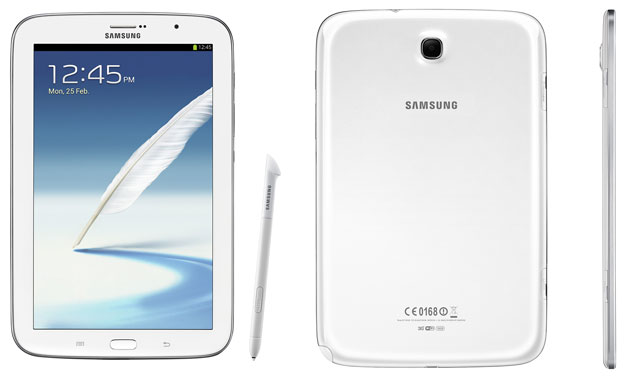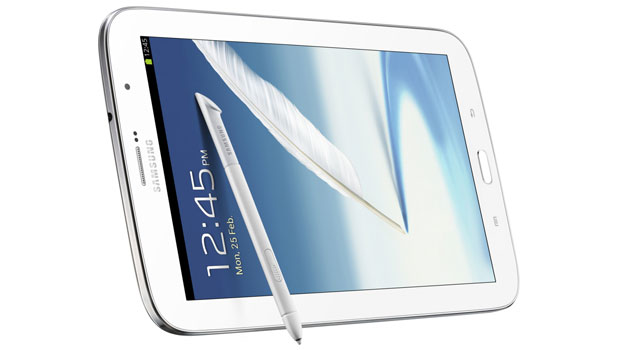
You have to hand it to Samsung. The company has made the most of its position as a leading component manufacturer by creating devices for every preference. What other company that already has a range of 7-inch and 10-inch tablets would also make an 8-inch version? The Galaxy Note 8 looks and behaves like its siblings. Unfortunately, though, it feels like them, too.
Unboxing the Galaxy Note 8, two things strike you immediately. The first is how much it resembles an iPad mini, and the second is how unpleasantly cheap its glossy rear cover feels. There’s no doubt Samsung has the resources to build beautiful aluminium-clad devices if it wished to, but perhaps its reliance on plastic is one of the many factors that allow it to build a wider range of devices than any other electronics company.
However, considering how many people wrap their devices in third-party cases, and given that Samsung continues to sell devices in the millions, this doesn’t appear to be enough to put many people off.
Also, aside from the Nexus 7 from Asus, there really isn’t another company making Android tablets worth considering. Of course, Sony, among others, is looking to change that later this year. For now, though, if you don’t want an iPad, Samsung’s most likely going to be your next stop.
One thing Samsung could do, however, is get rid of the awful water-themed array of sounds the device makes out of the box. Fortunately, the sound effects can be turned off, or changed.
As the name suggests, being part of the Note family of devices means the Note 8 comes with a stylus that’s stored in the rear panel of the device. The stylus doesn’t require batteries and has a physical button that allows you to select portions of the display and save them as images to the clipboard.
Tied to the stylus is a range of S Pen applications. These are grouped together on an additional home screen that appears only when the stylus is removed from the device. There are apps for note taking and sketching as well as variations on these two themes that allow you to create everything from recipes and birthday cards to travel journals.
For some, the S Pen and its accompanying apps will be the main reason to get a Samsung Note tablet, but we suspect most users will consider it a novelty addition and will barely use it. Unless you deliberately want to annotate a screenshot or document by hand, it’s just far more intuitive to use a finger.
So what’s the rest of the device like? Frankly, it’s excellent.
One of the best things about the Note 8 is its ability to multitask properly. With an application open, double-tapping the back button brings up a menu on the left-hand side of the display with icons for other applications. Dragging one of these to the right and into the screen opens it next to whatever you already have open. How much of the screen is assigned to each app is easily changed by dragging a thin bar between them.
Not every app is supported for the multitasking view, but the bulk of the most commonly used are, including Gmail, Chrome, alarm, contacts, gallery, maps, music, Google Talk and video player. It’s an incredibly easy-to-use feature, hugely flexible, and perhaps the best thing about the Note 8 and the Note series. Now you can look at a map while typing a message, or look at images in the gallery while making notes, or watch a video (adjustable to any size) while doing any number of other things.
Holding the device in portrait orientation, there’s a physical home button centred beneath the display, flanked by two capacitive buttons, one for additional options, and a back button. Above the display, there’s the front-facing camera, ambient light sensor and earpiece.
On the right-hand side of the device is the volume rocker, the lock/power button and an infrared transmitter. The top houses the 3,5mm audio jack, while the left-hand side has covered slots for micro-Sim and microSD cards, and the bottom is home to the two speakers and the micro USB port used for charging or data transfer — that’s right, Samsung’s blessedly done away with its proprietary connector this time around.

The built-in speakers on the bottom edge of the Note 8 are as average as one could expect. Because they’re so close to each other, they don’t really offer any stereo effect and they’re rather tinny.
From a specifications perspective, the Note 8 ticks all of the necessary boxes. It’s powered by a quad-core, 1,6GHz processor and 2GB of RAM, and comes in 16GB and 32GB variants, both expandable by a further 64GB via the microSD slot. All the usual sensors are present and accounted for and there’s a 4 600mAh battery that should allow for six to eight hours of heavy use. That’s not class-leading, but it’s not dreadful, either.
A big phone
In case the earpiece and Sim slot didn’t give it away, it’s worth mentioning that the Note 8 can be used as a phone. That’s not to say one should use it as a phone, only that one can.
Just as tablets look ridiculous when used as phones, they look equally ludicrous when used as cameras. Fortunately, Samsung will discourage the practice with the Note 8 by including a mediocre 5-megapixel rear camera. Like the camera on HTC’s One X, it’s a protuberance that costs the Note 8 points for aesthetic.
Samsung hasn’t hopped on the 1080p screen resolution bandwagon with the Note 8, despite having done so with the Galaxy S4 smartphone and is no doubt planning to with its next lot of 10-inch models. Instead, it’s settled for a 1 280×800-pixel display.
Of course, lower resolution displays are cheaper and more easily forgiven on smaller screens, but considering every top-end Android phone will have a 1080p display by year-end, it seems like a big corner to cut given the direct impact it has on the Note 8’s longevity.
Overall, the Note 8 is a capable device and one that offers more flexibility in terms of functionality than many of its rivals. However, this also makes it more of a niche product than the likes of the Nexus 7 or iPad mini. For those that merely want to consume content, as most tablet users do, it offers a slew of unnecessary features.
At the same time, if you’re the sort of person who wants to design your next house on a tablet computer while sipping champagne in KLM’s business class lounge, you’re probably the sort who’ll buy the 10,1-inch Note anyway.
The Note 8 embodies Samsung’s ability to cater for every conceivable niche and it’s an excellent device. But with a jaw-dropping recommended retail price in South Africa of R7 199 for the 16GB version — it costs $399 in the US — it’s impossible to recommend when you could buy other similarly capable devices and still have plenty of change left over. — (c) 2013 NewsCentral Media




